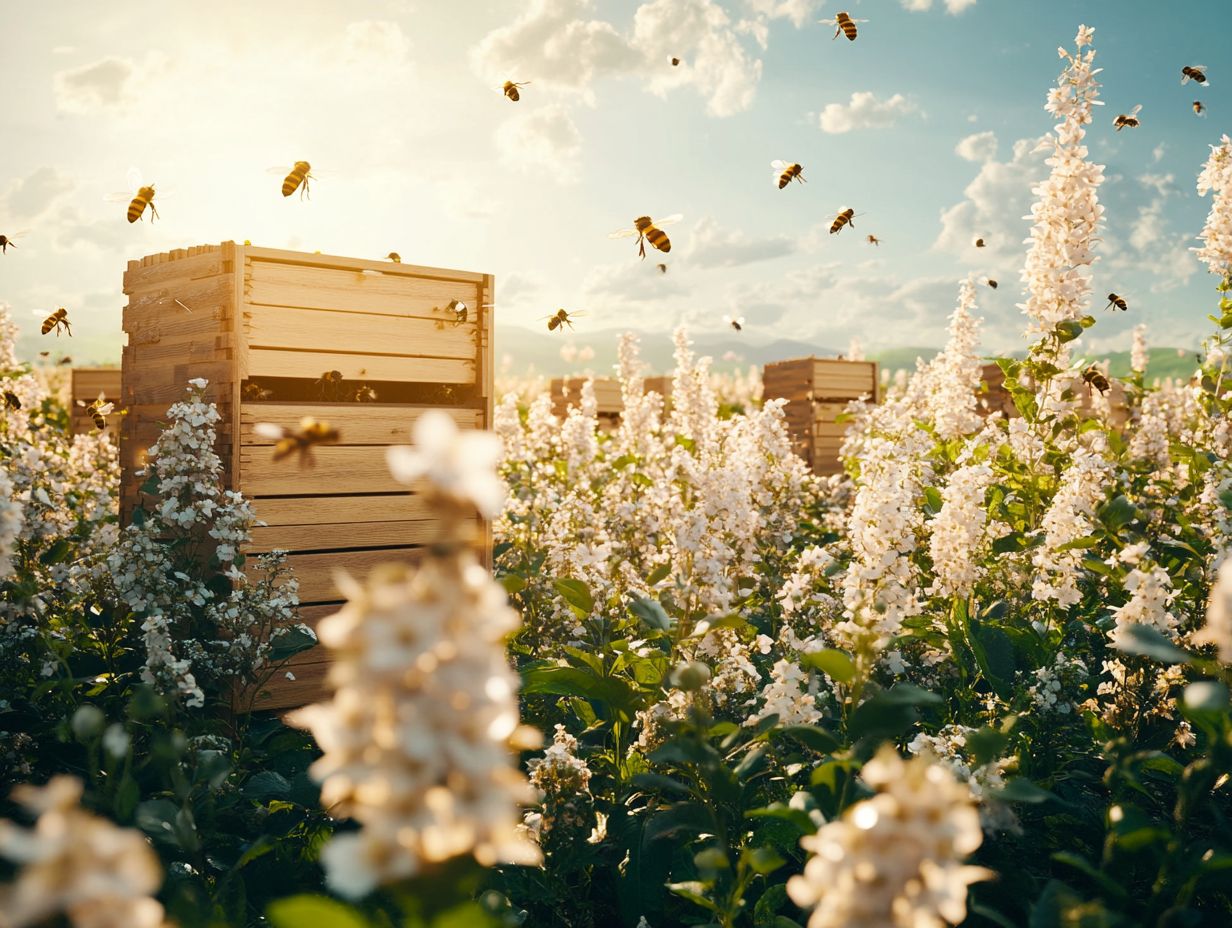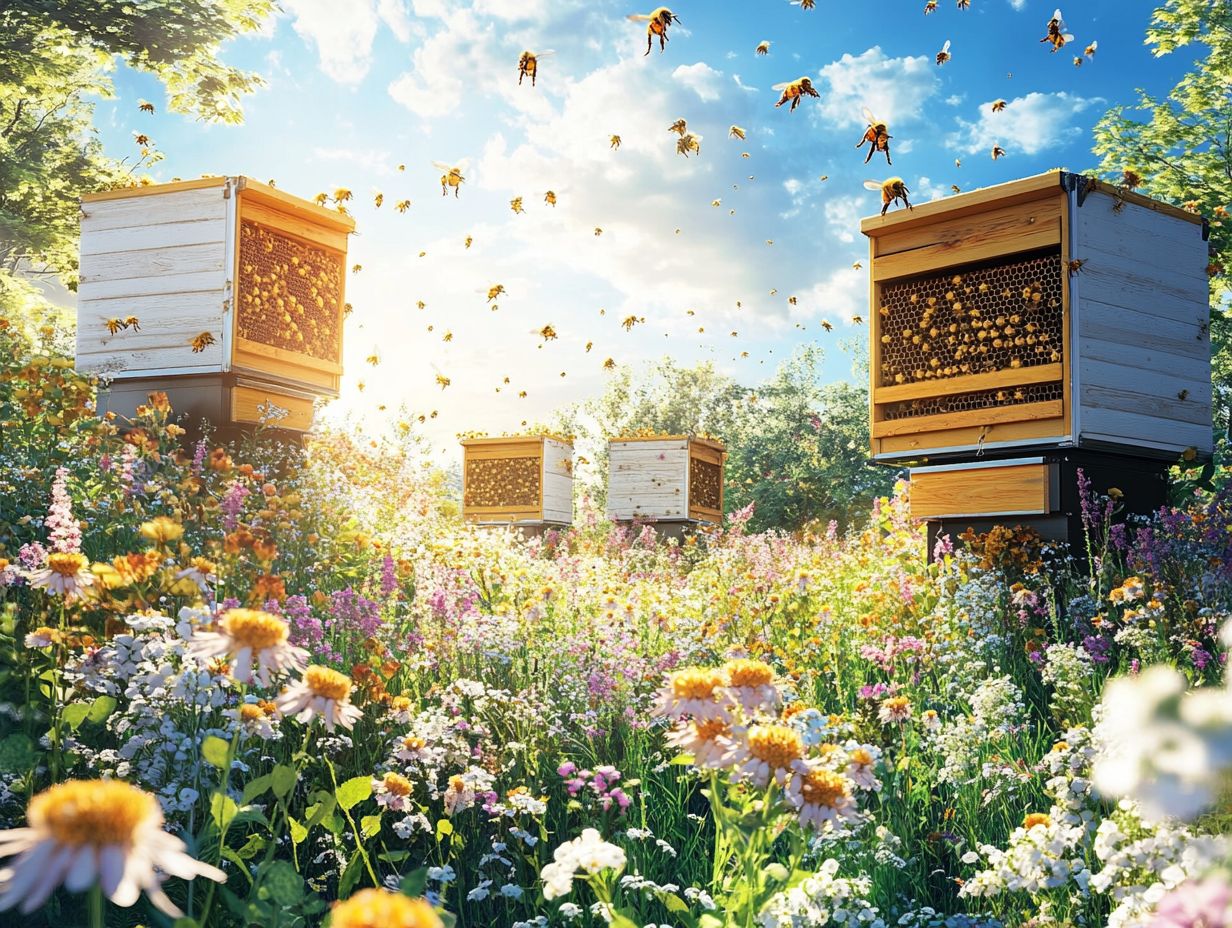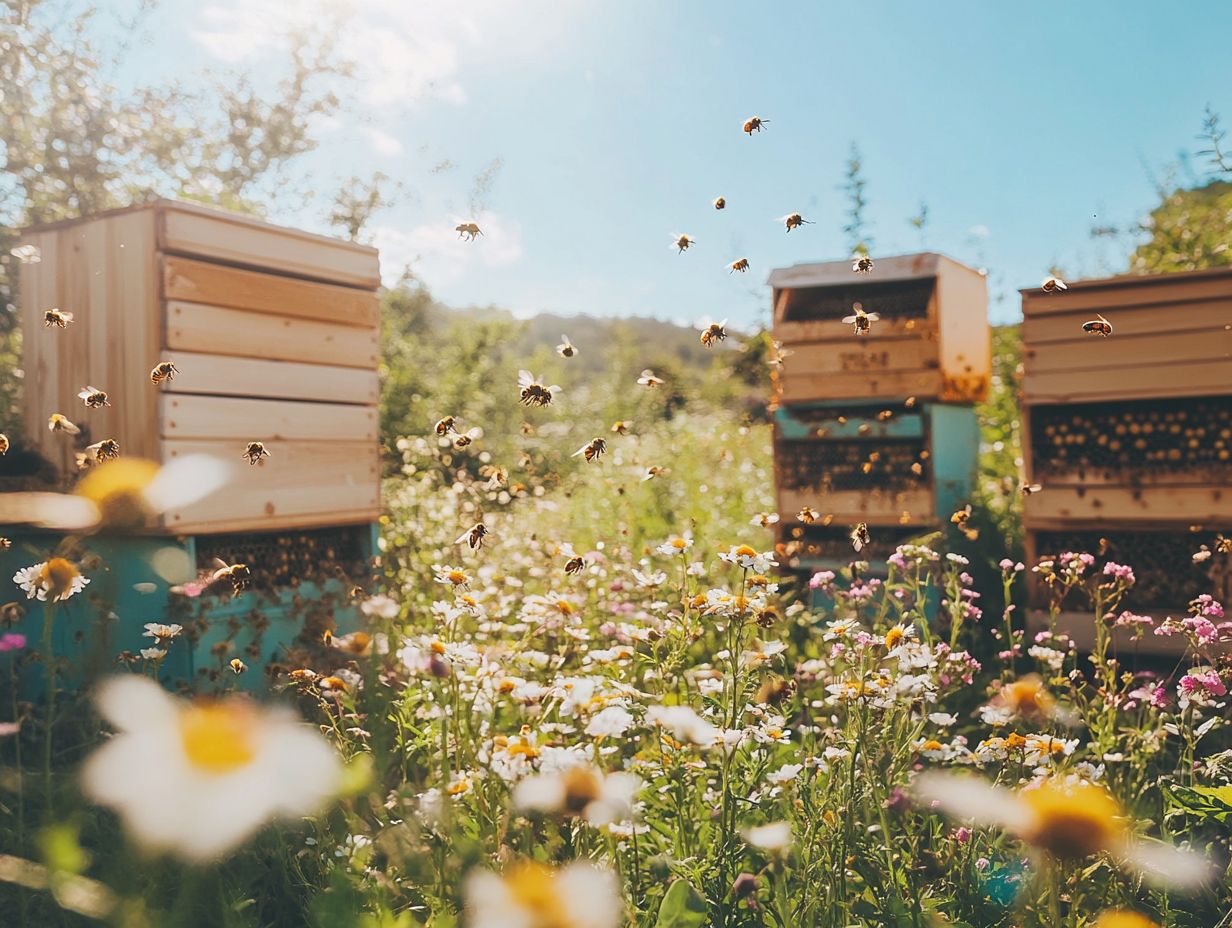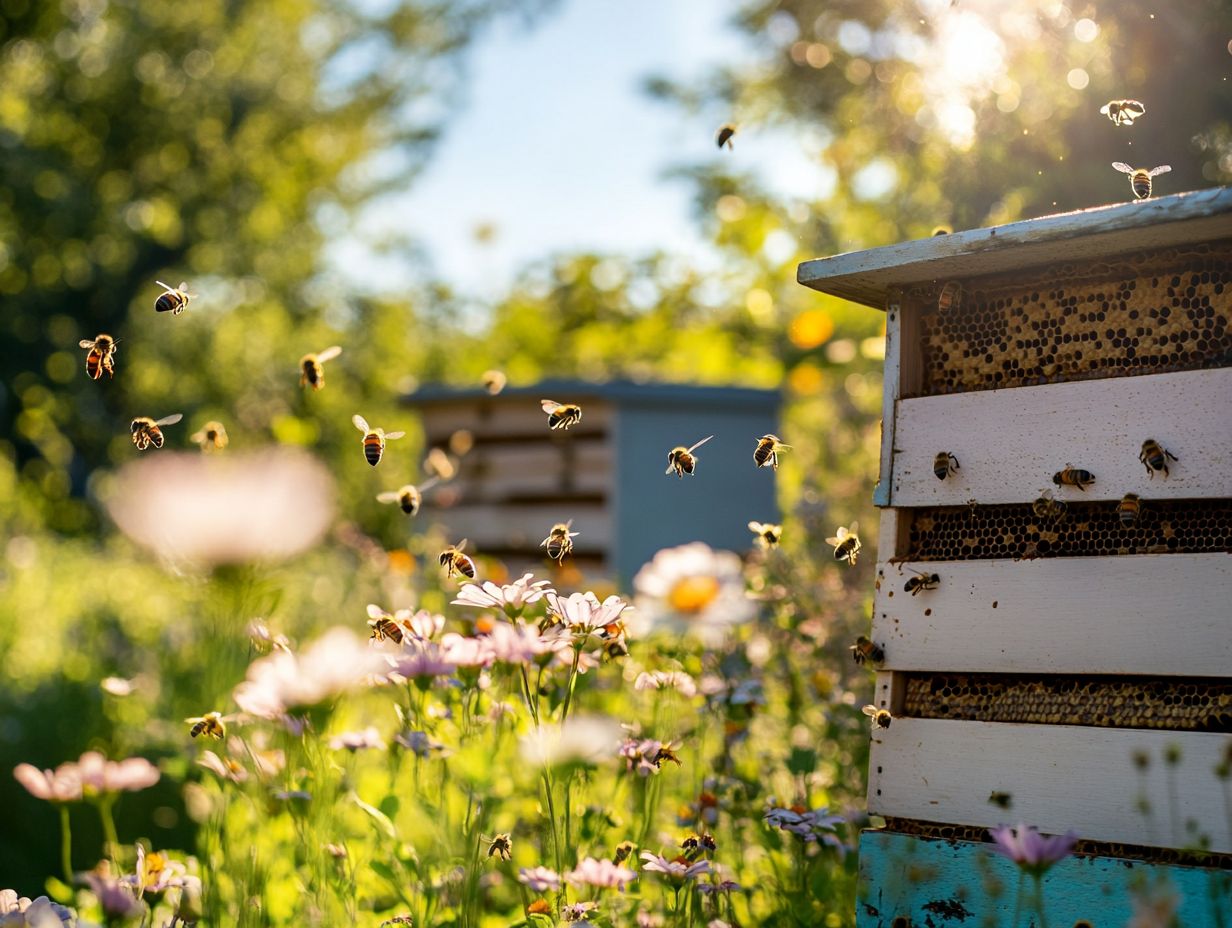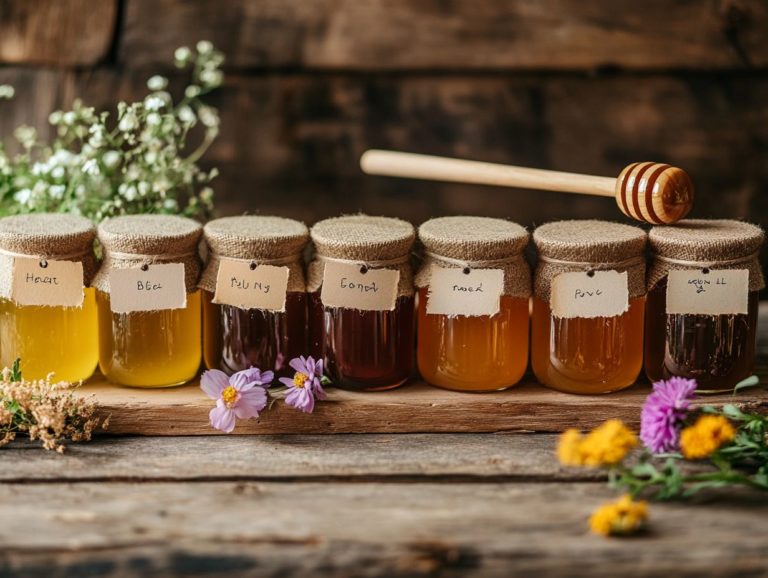How Climate Affects Honey Production
Honey production is closely linked to climate and influenced by extreme weather, with various environmental factors impacting honey yields significantly.
This article explores how different climates affect honey production, highlighting the most favorable and least ideal settings for beekeeping. It also outlines adaptive strategies for beekeepers looking to thrive amidst changing conditions.
Get ready to uncover amazing insights about honey production!
Contents
- Key Takeaways:
- How Does Climate Affect Honey Production?
- What Are the Best Climates for Honey Production?
- What Are the Worst Climates for Honey Production?
- How Can Beekeepers Adapt to Different Climates for Honey Production?
- Frequently Asked Questions
- How does climate affect honey production?
- What are the ideal climate conditions for honey production?
- How does a hot climate affect honey production?
- Can a cold climate affect honey production?
- How does climate change affect honey production?
- What can be done to mitigate climate change’s effects on honey production?
Key Takeaways:
- Climate plays a crucial role in honey production, affecting factors like temperature and precipitation.
- The best climates are temperate, subtropical, and tropical, ideal for bee activity and nectar production.
- Extreme cold, heat, and drought can harm bee health and overall honey yields.
How Does Climate Affect Honey Production?
Climate has a big impact on honey production, especially in the U.S.. Extreme weather events—like droughts and heavy rainfall—are increasingly affecting beekeepers and their managed colonies, changing where they search for food.
The relationship between climate change and honey production is complex. It impacts not just the health of honey bee colonies but also agricultural productivity, habitat loss, and ecosystem functions essential for food security.
Understanding the seasonal connections and environmental changes is vital for addressing the challenges that climate fluctuations pose to honey production and colony health.
1. Temperature
Temperature is important in honey production, directly influencing bee health and the number of bees that survive the winter, which is essential for maintaining a strong colony.
As temperatures change, bees adjust their foraging behaviors. In warmer conditions, they spring into action, exploring a wider range of available food sources. However, when cooler temperatures arrive, their ability to find food decreases, affecting their pollination success and ultimately impacting honey yield.
Climate change has intensified temperature extremes, leading to unpredictable seasonal changes that disrupt the natural cycles of flowering plants. This unpredictability creates significant challenges for managed colonies, as bees may emerge too early or too late, missing out on nectar, which can dramatically affect their productivity and the quality of the honey.
2. Precipitation
Extreme rainfall can greatly disrupt pollination services by affecting the availability of bee forage and contributing to habitat loss, impacting both wild species and managed colonies.
Consistent downpours often wash away essential nectar sources, making it harder for bees to find enough food. Under such conditions, floral health may suffer, as saturated soil and excess moisture create ideal conditions for mold and disease to thrive.
As a result, honey production becomes more unpredictable, prompting beekeepers to closely monitor weather patterns and adjust their management practices. You might need to relocate hives to areas with better food availability, diversify your pollinator-friendly plants, or modify your feeding strategies to keep your hives healthy in changing conditions.
3. Humidity
Humidity levels are essential to bee health and significantly influence the stability of the ecosystem surrounding honey production.
Bees thrive within specific humidity ranges crucial for their breathing ability and overall vitality. When humidity is too high, it can lead to excess moisture in hives, making them vulnerable to diseases and pests.
Conversely, low humidity may cause dehydration and stress among the bees. This delicate balance directly impacts how foragers collect nectar and pollen, affecting the hive’s productivity.
It’s vital for beekeepers like you to monitor and manage these environmental conditions, including stressors like Varroa mites and foodborne illness, meticulously.
By implementing strategies such as proper hive ventilation and thoughtful site selection, you can ensure your bees enjoy the best humidity for thriving. This not only fosters a healthier bee population but also significantly boosts your honey yields.
4. Wind
Wind can significantly influence the efficiency of pollination and the foraging behaviors of honey bee colonies, ultimately impacting your honey production.
In gusty conditions, these industrious creatures face challenges in navigating and locating blooming flowers, reducing their ability to collect nectar and pollen.
When the air becomes turbulent, bees expend more energy and find it difficult to land on flowers that sway unpredictably.
To tackle these challenges, beekeepers in windy areas often adopt various strategies, such as incorporating pollinator gardens to enhance ecosystem functions:
- Placing hives in sheltered locations
- Utilizing windbreaks like tall hedges or fences
- Choosing more resilient flower varieties that can withstand strong breezes
These thoughtful measures help create a more favorable environment for bees, ensuring they can gather the essential resources needed for their colonies and maintain honey production levels.
What Are the Best Climates for Honey Production?
The finest climates for honey production are distinguished by particular environmental conditions that foster abundant forage for bees and a favorable nectar flow (the movement of sugary fluids from flowers that bees collect).
Temperate, subtropical, and tropical climates each present unique advantages. For instance, temperate regions boast mild winters that enhance the overwintering populations, while subtropical and tropical areas offer extended flowering seasons that significantly elevate honey yields.
By grasping these climatic preferences, you can optimize your beekeeping practices, including employing community science projects to monitor local pollinator health for enhanced honey production.
1. Temperate Climates
Temperate climates present notable advantages for honey production, characterized by seasonal shifts that enhance pollination services and offer a variety of floral resources.
In these regions, you’ll find a well-defined spring, summer, autumn, and winter, each facilitating an array of blooms that entice bees throughout the growing season.
Take the Pacific Northwest, for example; early spring heralds the flowering of fruit trees, providing a vital nectar source. As summer unfolds, wildflowers and agricultural crops such as clover and sunflowers burst into bloom, enriching the foraging opportunities for bees.
This abundant floral diversity not only energizes bee activity but also plays a pivotal role in determining honey production cycles. Savvy honey producers in temperate zones often harness this seasonal rhythm, timing their harvests to align with peak nectar flows.
This strategic approach yields high-quality honey that beautifully reflects the local flora.
2. Subtropical Climates
Subtropical climates offer an exceptional backdrop for honey production, enabling you to enjoy year-round activity and a diverse array of bee forage.
In these regions, you’ll find milder winters and a wealth of flowering plants. This ensures a continuous supply of nectar and pollen throughout the seasons. For beekeepers, this means a reliable honey flow and the opportunity to harvest multiple times each year.
The rich plant life not only meets the bees’ dietary needs but also enhances the likelihood of producing unique and flavorful honeys.
However, it’s essential to be aware that subtropical areas can introduce certain challenges. You may encounter an increased risk of pests and diseases that thrive in warmer conditions. Additionally, potential extreme weather events could disrupt bee activity and foraging patterns.
3. Tropical Climates
Tropical climates boast an abundance of floral resources and steady temperatures, making them ideal for honey production.
In these vibrant environments, diverse plant species flourish year-round, providing beekeepers with extended foraging opportunities. Your bees can gather nectar and pollen without the disruptions of colder seasons.
These regions produce a wide variety of honey, each type showcasing unique flavors and colors that reflect the local flora.
This exceptional honey enriches the diets of local communities and acts as a vital economic engine. It significantly boosts incomes for beekeepers who can tap into both local markets and international exports, enhancing food security.
What Are the Worst Climates for Honey Production?
The most challenging climates for honey production often feature extreme cold, sweltering heat, and drought conditions. These factors can profoundly affect bee health and honey yields.
These environmental extremes not only impede the foraging abilities of honey bees but also pose serious threats to their overall health and survival. Recognizing these challenges is crucial for beekeepers like you, who must skillfully navigate the complexities of sustaining managed colonies in less-than-ideal climates.
1. Extreme Cold
Extreme cold presents considerable challenges for honey production, particularly by impacting the bees that survive the winter and the formation of winter clusters within bee colonies.
When temperatures drop, bees face the daunting task of maintaining warmth within their hives, a crucial element for their survival. This behavior compels them to huddle closely in tight clusters, generating heat by vibrating their wing muscles.
However, if the cold lingers too long, it can lead to a troubling increase in mortality rates. The scarcity of forage options during winter further compromises their health, as they typically rely on stored honey for nourishment.
To counter these risks, act now by insulating hives, ensuring there’s plenty of food available, and monitoring humidity levels. These measures are essential for nurturing resilient colonies, even in the face of icy conditions.
2. Extreme Heat
Extreme heat can place considerable stress on honey bees, directly impacting their health and productivity during honey production.
As temperatures rise, the stress on these vital pollinators can lead to diminished foraging efficiency and altered behavioral patterns. In intense heat, bees may struggle to navigate their surroundings, making it difficult for them to locate and gather pollen effectively.
This disorientation can disrupt the entire colony’s food supply, which is a serious concern. The repercussions of this shift extend beyond immediate honey production; they can also affect the overall health and resilience of the colony.
You, as a beekeeper, have the power to mitigate heat stress by implementing shade structures, ensuring access to fresh water, and managing hive ventilation. These proactive strategies can help stabilize the internal environment of the hive, fostering a healthier bee population that is better equipped to handle the challenges posed by rising temperatures.
Join the ranks of successful beekeepers by adapting to your climate!
3. Drought
Drought conditions can significantly hinder the availability of bee forage and raise concerns about nutritional security for bees and their colonies. This subsequently affects agricultural productivity.
As water sources dwindle, bees struggle to find essential pollen and nectar. This is crucial for their survival and the optimal functioning of their hives.
This nutritional deficit can lead to weakened immune systems, greater susceptibility to diseases, and ultimately, a decline in colony populations.
To address these challenges, consider adopting adaptive strategies such as:
- Relocating hives to areas with a more abundant supply of flowers
- Utilizing supplemental feeding with sugar syrup or protein patties
- Implementing water sources near beehives to ensure ecosystem functions remain intact
Taking action now is crucial to ensure bees get the nutrition they need. These measures can play a vital role in sustaining honey production, even amid adverse weather conditions such as extreme rainfall and drought.
How Can Beekeepers Adapt to Different Climates for Honey Production?
Beekeepers have the remarkable ability to adapt to varying climates for honey production by employing a range of strategies. This includes selecting the most suitable bee species, providing adequate shelter, and using extra food like sugar syrup.
Each climate presents unique challenges that necessitate tailored approaches to ensure the health and productivity of managed colonies. By gaining a deep understanding of local environmental conditions and the specific needs of their bees, beekeepers can enhance colony resilience and achieve impressive honey yields.
1. Choosing the Right Bee Species
Choosing the right bee species is essential for maximizing your honey production. Different species demonstrate varying levels of resistance to local climate challenges and pests like Varroa mites, including Varroa destructor.
To truly optimize your yields, understand the nuances of your local environment, including temperature, humidity, and seasonal variations. For example, if you’re in an area with harsh winters, hardier species like the Russian bee thrive due to their remarkable cold resistance.
Conversely, if you’re in a warm climate, the Italian bee often excels in prolific honey production and has a gentle nature.
Beekeepers selecting species suited to their climate often experience fewer losses and enhanced productivity. A noteworthy example from the Mediterranean region illustrates this: beekeepers who transitioned to the Carniolan bee saw a significant boost in honey output by adapting their practices to align with local flora and temperature patterns.
2. Providing Adequate Shelter
Providing adequate shelter for your hives is crucial to safeguarding your colonies from extreme weather while ensuring robust honey production.
Start by selecting a location that minimizes exposure to harsh winds and excessive moisture while maximizing sunlight during colder months. Consider placing your hives in areas with natural windbreaks, such as rows of trees or shrubs, which can effectively buffer against strong gusts that could disrupt your bees.
Implementing proper management practices is also key. Elevating your hives above the ground can help prevent flooding, thus enhancing the overall conditions for your bees. Regular maintenance is vital; consistently check for pests and diseases, and ensure adequate ventilation inside the hive to improve the health and productivity of your colony.
By thoughtfully addressing both shelter and management, you create an environment that fosters thriving bee populations, enhancing their role in pollination services and supporting agricultural practices.
3. Supplemental Feeding
Supplemental feeding, using options like sugar water and pollen substitutes, is essential for beekeepers to ensure food supply in colonies during challenging climates. This practice contributes to a healthy environment.
By providing sugar water in early spring or late fall, you guarantee your bees have available energy sources when foraging is limited due to colder temperatures. Introducing pollen substitutes during brood-rearing boosts protein intake, crucial for healthy larval growth. These practices strengthen the immune systems of honey bee colonies and enhance overall productivity, leading to improved honey yields.
Timing is crucial! Understanding the seasonal needs of your bees enables you to tailor your feeding strategies for optimal results, ensuring better alignment with seasonal connections.
Frequently Asked Questions
How does climate affect honey production?
Climate plays a crucial role in honey production as it impacts the availability of nectar and pollen for bees. Changes in temperature, rainfall, and weather patterns significantly affect plant growth, which is vital for honey production.
What are the ideal climate conditions for honey production?
The best climate for honey production is temperate, with consistent temperatures and moderate rainfall. Bees thrive in temperatures between 50-80°F and need a steady supply of nectar and pollen, typically found in areas with moderate rainfall.
How does a hot climate affect honey production?
A hot climate can hinder honey production by reducing the availability of nectar and pollen. High temperatures can dry out plants, leading to less nectar production and causing flowers to bloom earlier, shortening the honey production season.
Can a cold climate affect honey production?
Yes, a cold climate can significantly impact honey production. Bees are less active in colder temperatures, making it hard for them to collect nectar and pollen. This can decrease honey production and increase the risk of starvation during winter.
How does climate change affect honey production?
Climate change severely impacts honey production by altering natural cycles of plants and flowers. Changes in temperature and weather patterns can lead to unusual blooming times, reducing nectar and pollen availability, which threatens honey production and bee survival.
What can be done to mitigate climate change’s effects on honey production?
To mitigate climate change’s impact on honey production, adopt sustainable beekeeping practices and support environmental conservation. Planting bee-friendly flowers and reducing pesticide use help maintain a healthy environment for bees. Promote awareness and advocate for climate action to protect honey production and bee populations.

